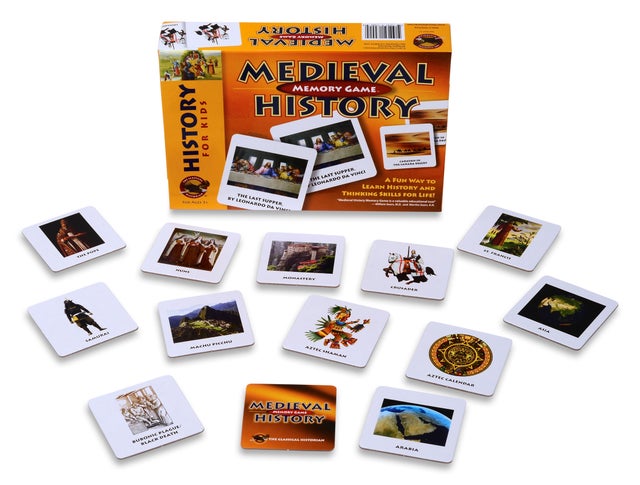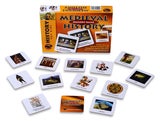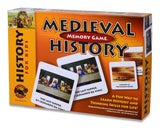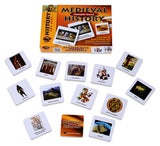- Store
- >
- Medieval History
- >
- Medieval History Memory Game
Medieval History Memory Game
SKU:
712
$14.99
$14.99
Unavailable
per item
Teach Medieval History with a game!
-
About
-
Specifications
-
History Game Bundles
-
Recommended Resources & Courses
<
>
Medieval History Memory Game
|
|
|
This memory game harnesses competitiveness for good. Instead of struggling through tedious memorization drills, have your students learn about history through play. No prior history knowledge necessary!
As students try to remember the location of their tiles, they'll encounter names and images associated with important historical people, places, and objects. The one who finds the most matching tiles wins!
Excellent for brain development, our games can be used as instructional lessons during the school day, or to pass the time on weekends. And by playing history games throughout summer vacation, you can ensure that your students will remember what they've learned during the school year.
We've been careful to create tiles that are both sturdy and beautiful. After playing, children will be eager to learn more about all the images on the tiles.
This Medieval History Memory Game was designed for kids ages five and up. It has 24 matching tiles for a total of 48 tiles. They are:
1. Castle
2. Medieval Battle
3. St. Francis
4. St. Peter's Basilica
5. Charlemagne
6. Nuns
7. Crusader
8. Monastery
9. The Pope
10. Cathedral of Notre Dame
11. The Last Supper, by Leonardo da Vinci
12. Mona Lisa, by Leonardo da Vinci
13. Pieta, by Michelangelo
14. Bubonic plague/Black Death
15. Aztec Shaman
16. Aztec Calendar
17. Machu Picchu
18. Mayan Pyramid
19. Caravan in Sahara Desert
20. Chinese Compass
21. Mongolian Warrior
22. Viking Warrior
23. Samurai
24. Asia
As students try to remember the location of their tiles, they'll encounter names and images associated with important historical people, places, and objects. The one who finds the most matching tiles wins!
Excellent for brain development, our games can be used as instructional lessons during the school day, or to pass the time on weekends. And by playing history games throughout summer vacation, you can ensure that your students will remember what they've learned during the school year.
We've been careful to create tiles that are both sturdy and beautiful. After playing, children will be eager to learn more about all the images on the tiles.
This Medieval History Memory Game was designed for kids ages five and up. It has 24 matching tiles for a total of 48 tiles. They are:
1. Castle
2. Medieval Battle
3. St. Francis
4. St. Peter's Basilica
5. Charlemagne
6. Nuns
7. Crusader
8. Monastery
9. The Pope
10. Cathedral of Notre Dame
11. The Last Supper, by Leonardo da Vinci
12. Mona Lisa, by Leonardo da Vinci
13. Pieta, by Michelangelo
14. Bubonic plague/Black Death
15. Aztec Shaman
16. Aztec Calendar
17. Machu Picchu
18. Mayan Pyramid
19. Caravan in Sahara Desert
20. Chinese Compass
21. Mongolian Warrior
22. Viking Warrior
23. Samurai
24. Asia
Name: Medieval History Memory Game
Publisher: Classical Historian
UPC: 713757179904
Contents: 48 Sturdy Tiles
Item #712
Publisher: Classical Historian
UPC: 713757179904
Contents: 48 Sturdy Tiles
Item #712
History Game Testimonial
"I am a sucker for games and I found some that I think are extraordinary...They are patterned after the vintage games of Concentration and Go Fish. I like these for the artistry, the simplicity and familiarity of the games, the historical value and perspective, and the reasonable price. Students using my series will easily identify most of Mr. De Gree's illustrated objects and places like Stonehenge, King Tut's golden mask, the Great Wall of China, and a Roman aqueduct. The "cards" for the Concentration/Memory Game are actually thick cardboard tiles, which are durable and easier for little ones to manipulate. The Go Fish card set gives you other game ideas that will be fun for all ages.
I could go on and on, because like I said, I'm a sucker for games and it's not easy to find quality ones for world history that even younger students can enjoy. I think the Classical Historian has done a great job. You may want to spice up your studies now, or save these for Christmas. Either way, I think they're great for review and the pure pleasure of having fun."
--Linda Hobar, Author, The Mystery of History
I could go on and on, because like I said, I'm a sucker for games and it's not easy to find quality ones for world history that even younger students can enjoy. I think the Classical Historian has done a great job. You may want to spice up your studies now, or save these for Christmas. Either way, I think they're great for review and the pure pleasure of having fun."
--Linda Hobar, Author, The Mystery of History








